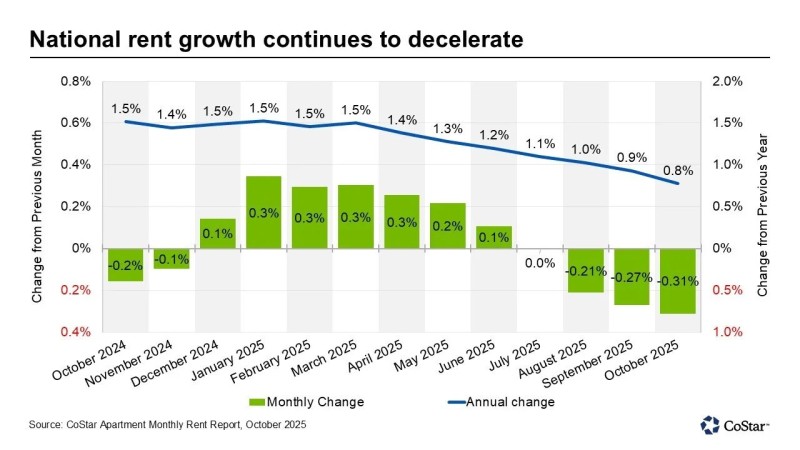The U.S. housing market is showing clear signs of deceleration as rental prices enter negative territory for the first time this year. Recent data from the CoStar Apartment Monthly Rent Report reveals a sustained cooling trend that's reshaping inflation expectations and could influence Federal Reserve policy decisions in the coming months. This shift marks a significant departure from the post-pandemic rental surge and suggests that housing-driven inflation may finally be losing steam.
Rent Data Signals Cooling Inflation Momentum
The latest national rent figures point to a decisive slowdown in the housing market, confirming a soft inflation trend. According to the CoStar Apartment Monthly Rent Report for October 2025, rents declined for the third consecutive month, highlighting a broader cooling pattern across the housing sector.

The numbers tell a compelling story: annual rent growth dropped to just 0.8%, down from 1.5% at the beginning of the year, while monthly rent changes fell to -0.31% in October, marking the sharpest decline of 2025. This combination of weakening monthly and yearly figures shows that rental price momentum has entered a sustained deceleration phase, easing inflation pressures within the shelter component of the Consumer Price Index.
Chart Analysis: Clear Downtrend in Rent Growth
The data reveals two consistent trends: a gradual decline in annual rent growth and a clear reversal in monthly rent momentum. From January through May 2025, monthly rents grew modestly at 0.3%, maintaining stable year-over-year gains near 1.5%. However, starting in August, growth turned negative and continued falling through October, culminating in the 0.31% monthly drop. This steady decline visually aligns with observations about soft inflation nowcasts and reflects structural shifts in the housing market, where surging new multifamily supply, waning demand, and affordability pressures are driving a correction after years of rapid rent inflation.
What's Driving the Rent Slowdown
- New Housing Supply Surges: Record levels of apartment completions across major metropolitan areas including Austin, Atlanta, and Phoenix are now outpacing renter demand, leading to localized oversupply and competitive pricing among landlords.
- Weaker Demand and Economic Uncertainty: Higher interest rates, wage stagnation, and lingering concerns over government spending cuts have cooled consumer sentiment. Many renters are staying put or downsizing rather than signing new leases at higher prices.
- Post-Pandemic Normalization: The extraordinary rent inflation of 2021–2023, driven by remote work migration and limited housing availability, is finally normalizing. Current rent declines reflect a rebalancing toward pre-pandemic pricing trends rather than a systemic downturn.
Broader Economic Implications
The slowdown in rental inflation could meaningfully reduce upcoming CPI readings, reinforcing expectations that overall U.S. inflation is easing. This development strengthens the case for potential Federal Reserve rate cuts in early 2026, particularly as shelter costs account for a major portion of consumer price data. However, while this trend is positive for policymakers and consumers, it poses challenges for property developers and REITs that depend on strong rent growth to sustain margins.
What's Next
If current patterns persist, national rents may post a year-over-year contraction by early 2026, a milestone not seen since before the pandemic. Economists anticipate stabilization in mid-2026 as new supply slows and rental markets adjust to lower demand levels. The CoStar October 2025 report confirms that national rent growth has turned decisively negative, signaling that housing-driven inflation is fading faster than expected. The data supports the view that the inflation cycle is entering a new phase, one marked by cooling shelter costs and the potential for a softer policy stance from the Federal Reserve.
 Eseandre Mordi
Eseandre Mordi

 Eseandre Mordi
Eseandre Mordi


